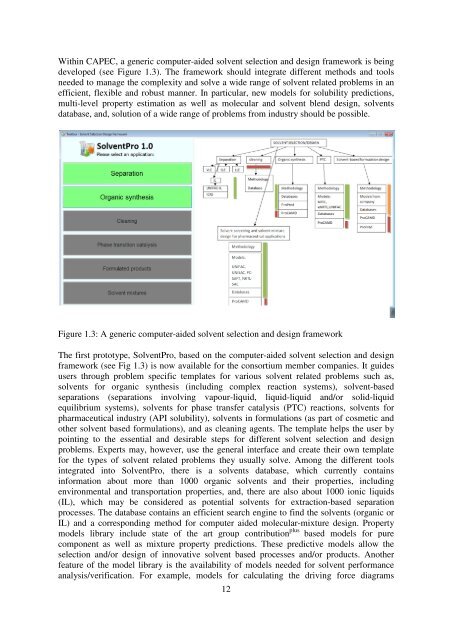PEC12-25 CAPEC-PROCESS Industrial Consortium ... - DTU Orbit
PEC12-25 CAPEC-PROCESS Industrial Consortium ... - DTU Orbit
PEC12-25 CAPEC-PROCESS Industrial Consortium ... - DTU Orbit
You also want an ePaper? Increase the reach of your titles
YUMPU automatically turns print PDFs into web optimized ePapers that Google loves.
Within <strong>CAPEC</strong>, a generic computer-aided solvent selection and design framework is being<br />
developed (see Figure 1.3). The framework should integrate different methods and tools<br />
needed to manage the complexity and solve a wide range of solvent related problems in an<br />
efficient, flexible and robust manner. In particular, new models for solubility predictions,<br />
multi-level property estimation as well as molecular and solvent blend design, solvents<br />
database, and, solution of a wide range of problems from industry should be possible.<br />
Figure 1.3: A generic computer-aided solvent selection and design framework<br />
The first prototype, SolventPro, based on the computer-aided solvent selection and design<br />
framework (see Fig 1.3) is now available for the consortium member companies. It guides<br />
users through problem specific templates for various solvent related problems such as,<br />
solvents for organic synthesis (including complex reaction systems), solvent-based<br />
separations (separations involving vapour-liquid, liquid-liquid and/or solid-liquid<br />
equilibrium systems), solvents for phase transfer catalysis (PTC) reactions, solvents for<br />
pharmaceutical industry (API solubility), solvents in formulations (as part of cosmetic and<br />
other solvent based formulations), and as cleaning agents. The template helps the user by<br />
pointing to the essential and desirable steps for different solvent selection and design<br />
problems. Experts may, however, use the general interface and create their own template<br />
for the types of solvent related problems they usually solve. Among the different tools<br />
integrated into SolventPro, there is a solvents database, which currently contains<br />
information about more than 1000 organic solvents and their properties, including<br />
environmental and transportation properties, and, there are also about 1000 ionic liquids<br />
(IL), which may be considered as potential solvents for extraction-based separation<br />
processes. The database contains an efficient search engine to find the solvents (organic or<br />
IL) and a corresponding method for computer aided molecular-mixture design. Property<br />
models library include state of the art group contribution plus based models for pure<br />
component as well as mixture property predictions. These predictive models allow the<br />
selection and/or design of innovative solvent based processes and/or products. Another<br />
feature of the model library is the availability of models needed for solvent performance<br />
analysis/verification. For example, models for calculating the driving force diagrams<br />
12
















